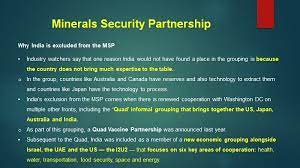
Minerals Security Partnership (MSP):
Minerals Security Partnership (MSP):
Rare Earth Elements
Mains Examination: General Studies Paper 2, 3
(International Relations and Rare Minerals)
July 25, 2023
Why in News:
- Recently, during Prime Minister Narendra Modi's visit to America, an agreement has been reached regarding rare earth elements, which will have far-reaching consequences.
Minerals Security Partnership' (MSP):
- It is a US-led multinational partnership aimed at building supply chains for energy and minerals.
- MSP is a strategic grouping of 13 member countries including Australia, Canada, Finland, France, Germany, Japan, Republic of Korea, Sweden, United Kingdom, US, European Union, Italy and now India. America started this ambitious initiative in June 2022.
- The Minerals Security Partnership (MSP) between India and the US aims to strengthen the supply chain of critical minerals around the world.
- India is going to be a part of the US-led Mineral Security Partnership or 'Minerals Security Partnership' (MSP) in the coming days. However, a long process of negotiation will go on in this direction. In fact, there is a possibility of increasing the use of rare mineral elements in the strategic sector all over the world. The superpowers of the world have gathered in developing new lethal weapons. Such policy efforts are being advocated, so that entrepreneurs working in the arms sector get adequate incentives.
- The partnership's stated objective is that critical earth elements should be 'produced, processed and recycled' in a way that allows each country to realize its full potential for economic development and take advantage of its geological resources.
- By joining the 'MSP', India will be able to become a part of a group of 12 other partner countries and the European Union. From the search for rare minerals to mining, processing and production, these countries are realizing the need to give strategic status to this sector and work is being done in this direction. These very rare minerals with 17 metallic elements are changing the axis of this change. These include scandium and yttrium, along with 15 lanthanides listed in the periodic table.
Position of Earth Elements Globally:
- Semiconductor manufacturing around the world is heavily dependent on these earth elements. These elements play an important role in making most of the electronics equipment. China has almost established a monopoly in the production of these minerals. China accounted for 90 percent of the world's total rare earth elements in 2008, and by 2011 China's share had increased to 97 percent.
- Due to trade disputes between China and America, the price of these minerals has increased a lot. According to freely available data, China consumes one lakh four thousand tons of rare earth elements every year, which is about 67 percent of the world's total consumption. Due to such a huge production capacity, it is possible to manipulate the price of rare earth elements globally and control the export of these elements. Australia, the world's fourth largest producer of rare earth elements with an annual production capacity of 24,000 tonnes, has benefited most from the rapid growth in demand. However, this production is much lower than China's 1,68,000 tonnes.
India's position in respect of Rare Earths:
- India's share in the world's reserves of rare earth minerals is six per cent. India is the fifth largest country in this matter. Till now the work of searching for minerals has largely been the responsibility of the government. The Bureau of Mines and the Department of Atomic Energy have been doing this work. The work of mining and refining has been with 'Indian Rare Earths Limited'.
- As a policy step, the Ministry of Mines amended the Mining Act in 2021, so that the production of minerals could be increased. Technology is needed for this and experts are considering India's participation in the 'Minerals Security Partnership' (MSP) as important for this need. The need to recognize it as a 'strategic area' is being emphasized in India. It is said to be necessary to fulfill the dream of progress in high technology to make chips and other important electronic equipment in India in the future.
Future Possibilities:
- In due course of time, through the US-led MSP, the region will acquire almost the same status as the Nuclear Suppliers Group (NSG). It was established in 1974. Australia and India emerging as partners that can strengthen and bring resilience to the rare metals supply chain.
- Global demand for rare metals is expected to reach 3,15,000 tonnes by 2030, mainly due to the global shift towards clean energy technologies such as electric vehicles, wind power and solar power. With China dominating the REE supply chain, many countries are moving towards collaboration.
Conclusions:
- India lacks a strategic plan for the rare earth element industry, but the government is still taking steps to promote the industry.
- India's entry into the MSP will give a fillip to several bilateral and multilateral agreements, especially for regimes involving critical minerals and their strategic importance, among member states.
---------------------------
Mains Exam Question
India is about to become a part of the 'Minerals Security Partnership' (MSP). What are the implications of this MSP for India? Discuss